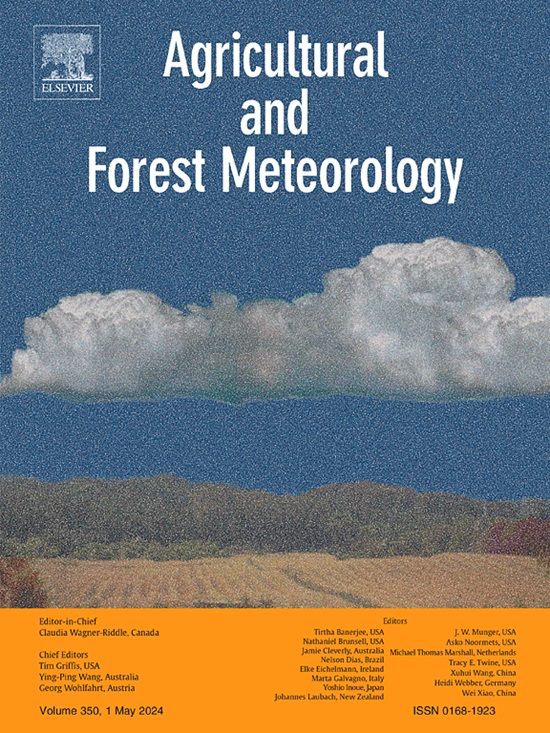幼龄农林复合系统中刺槐地上和地下生物量对植物总碳储量的贡献
IF 5.7
1区 农林科学
Q1 AGRONOMY
引用次数: 0
摘要
在地中海农林复合系统(AFS)中,树木生物量在地上和地下的分配记录很少,特别是幼树。本研究旨在(i)在样地尺度上描述土地利用(农林业、人工造林与人工林、TP)对5年生刺槐生长、树木生物量分配和树碳储量的影响,以及(ii)评估土地利用对总碳储量的影响(农林业、人工造林与作物单一栽培)。在样地尺度上建立了树木生物量的异速生长方程。在样地尺度上估算了三种土地利用方式的林下植被和作物生物量。在不同的光小气候条件下,AF的树径比TP高19%,而树高在不同的土地利用方式下差异不显著。在不同的土地利用方式下,树木在地上和地下的生物量分配(分别占总生物量的70%和30%)没有变化。农林业的单位面积林木碳储量积累效率高于人工林。树木分别占AF和TP地区生物量总碳储量的39%和66%。林下植被分别占AF区和TP区总碳储量的8%和34%。涉及树木、作物和林下植被碳储量的土地当量比值值尚未显示出与单一作物或乔木人工林相比,对植物碳积累的协同效应。本研究为幼龄AFS生物量碳储量提供了新的参考值。本文章由计算机程序翻译,如有差异,请以英文原文为准。
Contribution of aboveground and belowground biomass of Robinia pseudoacacia trees to total plant carbon stocks in a young agroforestry system
Allocation to aboveground and belowground compartments of tree biomass in Mediterranean agroforestry systems (AFS) is poorly documented, especially for young trees. This work aimed at (i) characterizing the effects of land use (Agroforestry, AF vs. Tree Plantation, TP) on 5-year-old black locust tree growth, tree biomass allocation, and tree C stocks at plot scale, and (ii) assessing the effect of land use on total carbon stocks (AF vs. TP vs. Crop Monoculture). Allometric equations were built for upscaling tree biomass at the plot scale. Biomass of understory vegetation and crops were estimated at the plot scale in the three land uses. Tree diameter was 19 % higher in the AF than in TP, likely due to different light microclimate, while tree height did not vary significantly between land uses. Tree biomass allocation to aboveground and belowground compartments (70 % and 30 % of total tree biomass, respectively) did not vary between land uses. Higher efficiency in building tree carbon stock was shown in agroforestry than in tree plantation per area unit. Trees accounted for 39 % and 66 % of total carbon stocks in biomass in AF and TP, respectively. Understory vegetation accounted for 8 % and 34 % of total carbon stocks in biomass in AF and TP, respectively. Land equivalent ratio values, which involved tree, crop and understory vegetation carbon stocks, did not yet indicate a synergetic effect on accumulation of plant carbon compared to sole crop or tree plantations. This study provides new reference values of carbon stocks in biomass in a young AFS.
求助全文
通过发布文献求助,成功后即可免费获取论文全文。
去求助
来源期刊
CiteScore
10.30
自引率
9.70%
发文量
415
审稿时长
69 days
期刊介绍:
Agricultural and Forest Meteorology is an international journal for the publication of original articles and reviews on the inter-relationship between meteorology, agriculture, forestry, and natural ecosystems. Emphasis is on basic and applied scientific research relevant to practical problems in the field of plant and soil sciences, ecology and biogeochemistry as affected by weather as well as climate variability and change. Theoretical models should be tested against experimental data. Articles must appeal to an international audience. Special issues devoted to single topics are also published.
Typical topics include canopy micrometeorology (e.g. canopy radiation transfer, turbulence near the ground, evapotranspiration, energy balance, fluxes of trace gases), micrometeorological instrumentation (e.g., sensors for trace gases, flux measurement instruments, radiation measurement techniques), aerobiology (e.g. the dispersion of pollen, spores, insects and pesticides), biometeorology (e.g. the effect of weather and climate on plant distribution, crop yield, water-use efficiency, and plant phenology), forest-fire/weather interactions, and feedbacks from vegetation to weather and the climate system.

 求助内容:
求助内容: 应助结果提醒方式:
应助结果提醒方式:


